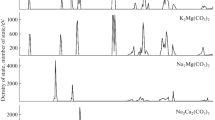Abstract
An empirical model for investigating the behaviour of CaCO3 polymorphs incorporating a shell model for oxygen has been created. The model was constructed by fitting to: the structure of aragonite and calcite; their elastic, static and high-frequency dielectric constants; phonon frequencies at the wave vectors [½ 0 2] and [0 0 0] of calcite; and vibrational frequencies of the carbonate deformation modes of calcite. The high-pressure phase transition between calcite I and II is observed. The potentials for the CO3 group were transferred to other carbonates, by refitting the interaction between CO3 and the cation to both the experimental structures and their bulk modulus, creating a set of potentials for calculating the properties of a wide range of carbonate materials. Defect energies of substitutional cation defects were analyzed for calcite and aragonite phases. The results were rationalized by studying the structure of calcite and aragonite in greater detail.
Similar content being viewed by others
Author information
Authors and Affiliations
Corresponding author
Rights and permissions
About this article
Cite this article
Archer, T., Birse, S., Dove, M. et al. An interatomic potential model for carbonates allowing for polarization effects. Phys Chem Minerals 30, 416–424 (2003). https://doi.org/10.1007/s00269-002-0269-z
Received:
Accepted:
Issue Date:
DOI: https://doi.org/10.1007/s00269-002-0269-z




